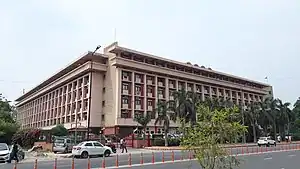 | |
 Rail Bhavan in New Delhi, the seat of the Ministry of Railways and the Railways Board | |
| Ministry overview | |
|---|---|
| Formed | March 1905[1] |
| Jurisdiction | Government of India |
| Headquarters | Rail Bhavan 1, Raisina Road, New Delhi, Delhi, India |
| Employees | 0.9 million (2022)[2] |
| Annual budget | ₹240,367.13 crore (US$30 billion) (2023–24 est.)[3] |
| Minister responsible |
|
| Deputy Ministers responsible |
|
| Ministry executive | |
| Child Ministry | |
| Website | www www |
The Ministry of Railways is a ministry in the Government of India, responsible for the country's rail transport. The ministry operates as the statutory body of the Indian Railways, an organisation that operates as a monopoly in rail transport and is headed by the Chairman and CEO of Railway Board. The Ministry of Railways along with the Railway Board is housed inside Rail Bhawan in New Delhi.
Organisational structure
The ministry has a Union Minister and Minister of State. A number of directorates report to the Railway Board. Most of the officers posted in Ministry of Railways are either from organised "Group A Railway services" or the Railway Board Secretariat Service.
Indian Railways
The statutory body reports to parliament and is under the ownership of Ministry of Railways of the Government of India. The Indian Railway Board comprises one Chairman, seven members of the Railway Board,[5] and a Financial Commissioner (who is the representative of the Ministry of Finance in the Railway Board). It also includes a Director-General (Railway Health Services, personnel, and Railway Protection Force).
The name change of railway stations in India require approval by the Indian Railway Board.[6]
Current members
Current Minister of Railways:
- Ashwini Vaishnaw[7] (2021-current)
Current Minister of State, Railways:
- Raosaheb Danve[8] (2021-current)
- Darshana Jardosh[8] (2021-current)
Present Members of Railway Board:
- Chairman and CEO of Railway Board : Jaya Varma Sinha,[4] IRTS
- Member Infrastructure: Roop Narayan Sunkar, IRSE
- Member (Traction and Rolling stock): Naveen Gulati, IRSEE
- Member (Operation and Business development): Jaya Varma Sinha(L/A),IRTS
- Member (Finance: ): Anjali Goyal, IRAS
- Director General (RHS): Dr.Sugandha Rana, IRHS
- Director General (RPF): Manoj Yadava,[9]IPS
- Director General (HR) : Mohit Sinha
- Director General (Safety) : Braj Mohan Agrawal
- Secretary: Ms. Aruna Nayar, IRPS
List of Railway Ministers of India from 1947 - Present
Below is the list of individuals who have served as the Railway Minister of India[10] from 1947 to till date.
- John Mathai (1947–1948)
- N. Gopalaswami Ayyangar (1948–1952)
- Lal Bahadur Shastri (1952–1956)
- Jagjivan Ram (1956–1962)
- Swaran Singh (1962–1964)
- S.K. Patil (1964–1966)
- Ram Subhag Singh (1966–1967)
- C. M. Poonacha (1967–1969)
- Panampilly Govinda Menon (1969–1970)
- K. Hanumanthaiya (1970–1971)
- T. A. Pai (1971–1974)
- L. N. Mishra (1974–1975)
- Kamalapati Tripathi (1975–1977)
- Madhu Dandavate (1977–1979)
- Kedar Pandey (1980–1981)
- Prakash Narain (1981–1982)
- A. B. A. Ghani Khan Choudhury (1982–1984)
- Bansi Lal (1984–1985)
- Madhavrao Scindia (1985–1989)
- George Fernandes (1989–1990)
- Janeshwar Mishra (1990–1991)
- C.K. Jaffer Sharief (1991–1995)
- Ram Vilas Paswan (1996–1998)
- Nitish Kumar (1998–1999)
- Mamata Banerjee (1999–2001)
- Nitish Kumar (2001–2004)
- Laloo Prasad Yadav (2004–2009)
- Mamata Banerjee (2009–2011)
- Dinesh Trivedi (2011–2012)
- Mukul Roy (2012–2014)
- D. V. Sadananda Gowda (2014–2014)
- Suresh Prabhu (2014–2017)
- Piyush Goyal (2017–2019)
- Piyush Goyal (2019–2021)
- Ashwini Vaishnaw (2021–Till Date)
| Accounts | Civil Engineering | Coaching | Computerization & Information Systems |
| Corporate Co-ordination | Economics | Efficiency & Research | Electrical Engineering |
| Establishment | Finance | Finance (Budget) | Finance (Expenditure) |
| Health | Infrastructure | Land & Amenities | Legal |
| Non Fare Revenue (NFR) | Management Services | Mechanical Engg | Mechanical Engg (PU&W) |
| Official Language | Pay Commission | Planning | Heritage |
| Public Relation | Environment Management | Transformation Cell | Railway Sports Promotion Board |
| Secretary Branches | Security | Signal | Statistics & Economics |
| Stores | Telecommunication | Track | Traffic Commercial |
| Traffic Transportation | Tourism & Catering | Vigilance | Works |
| Metropolitan Transport | IRCA | High Power Committee | Safety |
| High Level Committee for Railway Restructuring | Accounting Reforms | Passenger Amenities Committee | Documents laid in Lok Sabha |
| Mobility | Technology Mission for Indian Railways | Advisory Group of Experts (AGE) | Bridge & Structure (B&S) |
History
In 1901, on the recommendations of Sir Thomas Robertson Committee regarding the administration and working of the railways, an early version of the railway board was constituted. It initially had three members.
In 1905, its powers were formalised by Lord Curzon's government. Its membership consisted of a Government Railway official, who was the chairman of the board, a railway manager from England and an agent of a Company Railway. The board was placed under the Department of Commerce and Industry of the Indian Government.
In 1921, a reorganisation of the Railway Board was carried out, and a Chief Commissioner of Railways was appointed, who was solely responsible to the Government for decisions on technical matters and for advising the Government on matters of policy. Pursuant to the Acworth Committee's recommendations in 1921, the Railway Board was reconstituted with effect from 1 April 1924. The reconstituted board consisted of the Chief Commissioner, a Financial Commissioner and two members. One was responsible for ways and works, and projects and stores. The other was responsible for general administration, staff and traffic.
In 1929, an additional post at the member level was added to the board. It was given responsibility for staff, so that the member in charge of traffic could focus solely on transport and commercial matters. During this time, Frank D'Souza became the first Indian member of the board.[11]
In April, 1951 the post of Chief Commissioner was abolished and the senior-most functional member was appointed the chairman of the board, resulting in a membership of four.
In October 1954, the chairman of the board was made responsible for decisions on technical and policy matters, with the status of a Principal Secretary to Government in the Ministry of Railways. One more Member was also added and the strength of the Board again became five.[12]
In 1988, a new member with responsibility for signals, telecommunication and electrical matters was added to the board. On 16 April 2019 two more members, one with responsibility for signals and telecommunications, and another for material management, joined the board. At this point, the Railway Board had a strength of eight—a Chairman, and seven members. The Chairman is assisted by officers of Railway Board Secretariat Service.
On 24 December 2019, the Union Cabinet decided to reduce the size of the board from eight to five. It also decided to merge its different cadres into a single Railway Management Service. The newly constituted Board will have Members for "Operation, [sic] Business Development, Human Resources, Infrastructure and Finance".[13]
Railway Budget
The East India Railway Committee, chaired by Sir William Acworth reported that there was a need for unified management of the entire railway system. On the recommendations of this committee and ratification of a resolution to do so in 1921, the government took over the actual management of all the railways, and also separated the railway finances from the general governmental finances. It also began to present the Railway Budget separately from the general budget of India every year. The Railway Board was expanded to have a Financial Commissioner, a member in charge of ways, works, stores and projects, and a member in charge of administration, staff, and traffic. Accordingly, from 1 April 1929, the responsibility for the compilation of accounts for the Railways was taken over by the Financial Commissioner, Railways from the Auditor General.
The last Railway Budget[14] was presented on 25 February 2016 by Mr. Suresh Prabhu. The Modi government on 21 September 2016 approved merger of the rail and general budgets from 2017, ending a 92-year-old colonial era practice of a separate budget.[15]
Controversies
On 14 February 2008, Westinghouse Air Brake Technologies Corporation, listed on the New York Stock Exchange, admitted to violating Foreign Corrupt Practices Act (FCPA) regulations by making improper payments from its subsidiary Pioneer Friction Limited, based in Kolkata, to government officials of the Indian railway board. Payments were made in order to obtain and retain business with the Railway Board and curb taxes.[16]
On 3 May 2013, the CBI arrested then Minister of Railways Pawan Kumar Bansal's nephew, Vijay Singla for accepting an alleged bribe of ₹9 million (US$110,000), which was part of a larger sum of Rs. 100 million (US$16.2 million) from a middleman on behalf of Mahesh Kumar, in return for his appointment as Member (Electrical) of the Railway Board.[17][18][19] Mahesh Kumar was suspended, although the Railway Board clarified that no rules had been broken during the appointment of Mahesh Kumar.[20]
References
- ↑ "ECR to observe Railway Week today". The Times of India. India. 15 April 2010. Archived from the original on 4 November 2012.
- ↑ Indian Railways Year Book (2009–2010) (PDF). Ministry of Railways, Government of India. 2011. p. 13. Retrieved 26 August 2008.
- ↑ "Union Budget 2020-21 Analysis" (PDF). prsindia.org. 2020. Archived from the original (PDF) on 26 February 2020.
- 1 2 "Govt appoints Jaya Verma Sinha as first woman CEO, chairperson of Railway Board". livemint.com. 31 August 2023. Retrieved 31 August 2023.
- ↑ corporate overview of Indian Railways Ministry
- ↑ "Name change requires Railway Board's nod". The Hindu. 10 September 2018. Retrieved 24 October 2021.
- ↑ "Ashwini Vaishnaw, ex-IITian and MBA graduate from Wharton, takes charge as IT, Railway Minister". 8 July 2021.
- 1 2 "Darshana Vikram Jardosh, Raosaheb Dadarao Danve take charge as MoS for Railways".
- ↑ "Centre appoints IPS officer Manoj Yadava as DG Railway Protection Force". adda247.com. 20 July 2023. Retrieved 20 July 2023.
- ↑ "Full List of Railway Minister of India [1948 – 2023]". Notes Press. Notes Press.
- ↑ The Goans of Karachi, have a history of their own Goas of Pakistan. Retrieved 1 October 2010.
- ↑ Rao, M.A. (1988). Indian Railways, New Delhi: National Book Trust, pp.49-54
- ↑ Cabinet approves restructuring of Railway Board
- ↑ "After 92 years, Rail Budget is history". Business Standard India. 22 September 2016. Retrieved 24 March 2017.
- ↑ "Railway budget to be merged with General budget from 2017". The Hindu. 14 August 2016 – via www.thehindu.com.
- ↑ Department of Justice (14 February 2008). "Westinghouse Air Brake Technologies Corporation Agrees to Pay $300,000 Penalty to Resolve Foreign Bribery Violations in India". Department of Justice.
- ↑ "Bansal's nephew remanded in CBI custody, Congress core group meets". The Times of India. 4 May 2013. Archived from the original on 7 May 2013. Retrieved 5 May 2013.
- ↑ "Pawan Kumar Bansal's nephew booked by CBI for accepting Rs 90 lakh bribe". The Times of India. Archived from the original on 6 May 2013.
- ↑ "Railway Minister Pawan Bansal's nephew arrested by CBI for allegedly accepting bribe". NDTV.com.
- ↑ "Mahesh suspended, nephew arrested; What about Pawan Kumar Bansal?". Dainik Bhaskar. 4 May 2013. Retrieved 5 May 2013.